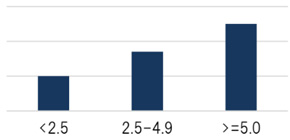
Long-time Television Viewers have Higher Risk of Fatal Pulmonary Embolism
Summary of the finding
We found that prolonged television viewing was associated with an increased risk of pulmonary embolism death among Japanese. This is the first study in the world to find the significant association between long-time television watching and fatal pulmonary embolism. This result is obtained examining data of approximately 86 000 Japanese men and women, aged 40 to 79, after a follow-up from 1988 to 2009.
What is pulmonary embolism?
Pulmonary embolism is a severe, sometimes fatal, lung-related disease characterized by sudden onset of symptoms such as chest pain or difficulty in breathing. Cause of the disease is obstruction of pulmonary arteries by blood clots, generally formed in leg vessels. Cancer, prolonged bedrest or sitting, and oral contraceptive use can be risk factor of pulmonary embolism. Historically, the association between prolonged sitting and the risk of pulmonary embolism was firstly reported among air-raid shelter users in London during World War II. Nowadays, long-time flight in economy class seat is a well-known cause of pulmonary embolism, named “economy class syndrome.”
Long-time television viewers had higher risk of pulmonary embolism death
We observed that prolonged television watching was associated with higher risk of fatal pulmonary embolism among Japanese men and women. Precisely, people whose average television viewing time more than five hours per day had 2.5 times higher risk as those of less than two and half hours.

The JACC Study
Data was from the Japanese Collaborative Cohort Study (JACC Study), a large-scale medical study aimed at investigating how individual lifestyle affects disease mortality and cancer morbidity. The JACC Study was established in 1988 with approximately 120 000 Japanese men and women, aged between 40 and 79. They were asked their lifestyles including daily average television viewing at the beginning of study, and then followed-up for their death and its cause until 2009. Over 200 original articles have been published from the JACC Study.
Public health implication
We showed that prolonged television viewing may be a risky behaviour for death of pulmonary embolism. Leg immobility during television viewing may in part explain the finding. To prevent the occurrence of pulmonary embolism, we recommend the same preventive behaviour against the economy class syndrome. That is, take a break, stand up, and walk around during the television viewing. Drinking water for preventing dehydration is also important.
Future direction
In the era of information technology, use of other visual-based media device such as personal computer or smartphone is becoming popular. There is a case report from Korea of 24-year-old unemployed male who died of pulmonary embolism death after long time play of internet game. As for in relation to smartphone use, to our knowledge, no case of pulmonary embolism has been reported. It is important to be aware of the risk of pulmonary embolism by long time leg immobility as well as to assess the risk of such new technology use in terms of pulmonary embolism morbidity.
To learn more about this research, please view the full research report entitled “Watching Television and Risk of Mortality From Pulmonary Embolism Among Japanese Men and Women: The JACC (Japan Collaborative Cohort) Study” at this page of the Circulation website.
Related links
